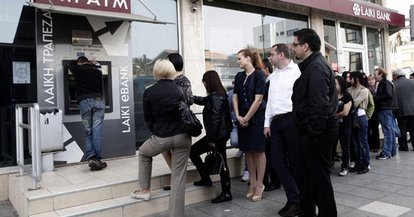After the main fear for all Cypriot bank deposit holders, Cyprus’s central bank announced that only savers with more than €100,000 in Bank of Cyprus, the island’s biggest lender, would lose 40% of their savings as part of the radical restructuring and downsizing plan agreed by President Nicos Anastasiades and eurozone leaders in Brussels on Sunday in order to receive the 10 billion aid package need to avoid default. The losses to savers comes on top of the wipe-out of €4.2bn of deposits at Laiki or Cyprus Popular, the country’s second bank which is being closed down and its good assets transferred to Bank of Cyprus.
The European commission and influential MEPs involved in drafting new laws on resolving bank failures confirmed that the proposed rules would include “bail-ins”, which are favoured by Germany and would see investors and savers taking the hit instead of taxpayers. But such a rescuing management could fuel a mass bank run throughout the eurozone as millions of bank deposit holders in the most troubled countries, such as Slovenia, Spain and Italy, could fear to have a levy on their savings.
European Central Bank executive board member Benoit Coeure said on Tuesday that Eurogroup chief Jeroen Dijsselbloem was “wrong” to suggest on Monday that the restructuring of the Cypriot banking system will serve as a model for other countries. He has been promptly echoed by French President François Hollande who stated in a joint press conference with Spanish Prime Minister Mariano Rajoy that “the guarantee of bank deposits must be an absolute and irrevocable principle”, showing in so doing that even the French are afraid of such a model.
The European Commission did not help shed some light on the issue. “It is not excluded that deposits over €100,000 could be instruments eligible for bail-in,” said Chantal Hughes, spokeswoman for Michel Barnier, the European commissioner for the single market drafting the banking resolution legislation. Again what a mess.
Without wondering too much whether and to what extent a bail-in procedure is to be applied in case of bank default (and above all up to what limit bank deposits are guaranteed in any case), an aspect has not been discussed as deserved: the long waited European Stability Mechanism ESM. In June last year, an EU summit for the first time agreed that the eurozone’s bailout fund, the European Stability Mechanism, could be used directly to recapitalise ailing banks without the loans being added to government debt. It was a breakthrough engineered by France, Italy, and Spain but opposed by Germany, which has since sought to neuter the idea. Following the Cyprus deal, where none of the €10bn in bailout funds will be used to recapitalise banks, unfortunately the idea is not on the table any more. Nevertheless the EMS would be the only European response to the crisis of a member states, but again the solution is sought at intra-national level with the Eurogroup unsure of its own position. Definitely, what a mess, and what a pity.


1. On 30 March 2013 at 13:23, by Protesilaos Stavrou Replying to: Is Cyprus a model for Europe of how to rescue a State?
Replying to: Is Cyprus a model for Europe of how to rescue a State?
Hi Alessio! Here are a few thoughts on some of your remarks:
At first, the scheme of bail-ins in Europe has not been standardized. Any discussion on the “nature” or modalities of bail-ins is essentially established on rumours, inchoate truths, incomplete plans and a dose of speculation. It is certainly fair to suggest that the zeitgeist in Brussels (and Berlin) favors bail-ins. However, what is currently being contemplated upon, is to make this an integral part of the range of powers that will fall under the soon-to-be-established Single Resolution Mechanism (SRM). The SRM will complement the Single Supervisory Mechanism (SSM) that will on its own accord be integrated in the spectrum of duties of the European Central Bank, by 2014. This implies an institutionalization of the bail-in scheme; one that will make the whole operations predictable, transparent and “European” (as contrasted to sub-optimal and arbitrary deals deriving from inter-governmental bargaining).
Secondly, by “bail-ins” we ought to understand that deposits are in principle the last to be touched. Those who are forced to exchange debt for equity are senior bondholders, junior bondholders and then unsecured depositors. Those whose deposits are secured cannot be touched in principle and the fact that the original agreement of the Eurogroup on Cyprus did just that, shows, inter alia, the shortcomings of the inter-governmental modus operandi, not of the bail-ins per se.
Concomitant with this is that bail-ins as contrasted to bail-outs do not protect those who ventured to speculate on the bank. Those who took the risk are those who bear the cost. In this regard, bail-ins are inherently heterogeneous as their anatomy is determined by the specific conditions that apply to each problematic bank; whereas bail-outs apply without serious consideration of the specifics, and hence end up provided pampers to those who contributed to the failure in the first place. Bail-outs were hitherto preferred only because of their convenience in administrative terms, not their economic, legal and moral superiority (and also due to the fact that the Economic and Monetary Union’s institutional architecture was inadequate and had no mechanisms for satisfactory and effective alternative action). That granted, bail-ins will eventually become the new orthodoxy, but they will differ substantially from the awkward deal on Cyprus (always with respect to the specific peculiarieties of the profoundly unsustainable Cypriot economic model).
Thirdly, the ESM has limited funds and cannot just distribute them as if these are blank checks. The ESM is not a cornucopia, nor should it engender incentives to policy-makers to perceive it as such. The ESM will be the ultimate fiscal backstop once it is woven together with the Outright Monetary Transcactions of the European Central Bank. As such, it ought to be inferred that the ESM has a very important function to perform, but it is not that of a “generous” supporter of failed business practices.
Lastly, for the above to be placed in a coherent institutional framework, there eventually needs to be further integration towards a genuine banking union, featuring a single deposit guarantee scheme; and eventually other fiscal measures that will preempt or at least ameliorate any asymmetric shocks that can otherwise be fostered in a flawed polico-institutional context.
2. On 31 March 2013 at 17:44, by Niklas Replying to: Is Cyprus a model for Europe of how to rescue a State?
Replying to: Is Cyprus a model for Europe of how to rescue a State?
“In June last year, an EU summit for the first time agreed that the eurozone’s bailout fund, the European Stability Mechanism, could be used directly to recapitalise ailing banks without the loans being added to government debt.”
“Nevertheless the EMS would be the only European response to the crisis of a member states, but again the solution is sought at intra-national level with the Eurogroup unsure of its own position.”
First of all I dont see what is so European about bailing out every bank, no matter what sort of economic model they have chosen and what sort of savers there are. Also the ESM is money, not comming from a blue heaven. Second I dont agree with your point of view, that it is only Germany, which is taking a view on a stricter bailout system, but that is also other countries like Austria, Finnland, Netherlands aswell as other East European countries. It is also not very European to put up this image of Germany being the only one, not wanting to play a European game, since it evokes one-sighted hatred-speach. With a strict limit of 100.000 (which is already a lot) I think it is highly exaggerated to draw a bank run on the wall. However I can agree to a small savers deposit insurance scheme within the Banking Union, but that cannot mean to bailout every bank and to forget about any sort of responsibility. People with 100.000 Euro are mostly thinking very well about there savings. Therefore they should also take the risk if they want to profit from risky investments. We can discuss the question of whether it would be contagious if you call it a sort of model. But if you look at the Cyprus case, there has been no reaction in Spain for example, which on the contrary managed to get bonds just some days ago for one of the best spreads since a long time...
Follow the comments: |
|
